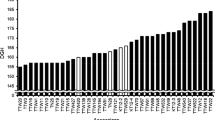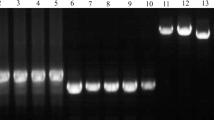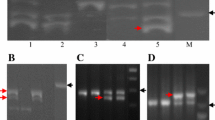Abstract
Main conclusion
The distribution of early flowering alleles of VRN-A3 was found to be biased to low latitudes, and these alleles may contribute to environmental adaptability to low latitudes in cultivated emmer wheat.
Abstract
In wheat (Triticum spp.), the flowering time is an important trait for successful seed production and yield by adapting to the regional environment. An early flowering allele of VRN-A3 with 7- and 25-bp insertions in the promoter region (Vrn-A3a-h1) has recently been reported from the analysis of an emmer wheat (Triticum turgidum L. ssp. dicoccum) accession, TN26. This early flowering allele of VRN-A3 might be associated with the regional adaptation of wheat. In this study, we elucidated its geographic distribution to assess the importance of the early flowering allele of VRN-A3 in worldwide wheat collection. From sequence analysis, we identified six VRN-A3 alleles with the 7- and 25-bp insertions, namely, Vrn-A3a-h2, Vrn-A3a-h3, Vrn-A3a-h4, Vrn-A3a-h5, Vrn-A3a-h6, and Vrn-A3c-h2 from wild emmer wheat, while we identified two VRN-A3 alleles with these insertions, Vrn-A3a-h2 and Vrn-A3c-h1 from cultivated tetraploid and hexaploid wheat species in addition to Vrn-A3a-h1. Among VRN-A3 alleles distributed in cultivated wheat, we found that Vrn-A3a-h2 promoted early heading, whereas Vrn-A3c-h1 did not affect heading time. Our analysis showed that the distribution of early flowering alleles of VRN-A3 dominated in cultivated emmer wheat in Ethiopia and India, which actually showed an early flowering phenotype. This implied that the early flowering alleles of VRN-A3 contribute to adaptability to a low-latitude environment in cultivated emmer wheat. We could not find durum (T. turgidum L. ssp. durum) and bread wheat (T. aestivum L. ssp. aestivum) accessions with these early flowering alleles. Our findings indicated that Vrn-A3a-h1 and Vrn-A3a-h2 were useful for breeding of early flowering cultivars in durum and bread wheat varieties.





Similar content being viewed by others
References
Alvarez MA, Tranquilli G, Lewis S, Kippes N, Dubcovsky J (2016) Genetic and physical mapping of the earliness per se locus Eps-Am 1 in Triticum monococcum identifies EARLY FLOWERING 3 (ELF3) as a candidate gene. Funct Integr Genomics 16:365–382. https://doi.org/10.1007/s10142-016-0490-3
Arjona JM, Royo C, Dreisigacker S, Ammar K, Villegas D (2018) Effect of Ppd-A1 and Ppd-B1 Allelic variants on grain number and thousand kernel weight of Durum wheat and their impact on final grain yield. Front Plant Sci 9:888. https://doi.org/10.3389/fpls.2018.00888
Bandelt HJ, Forster P, Rohl A (1999) Median-joining networks for inferring intraspecific phylogenies. Mol Biol Evol 16:37–48
Beales J, Turner A, Griffiths S, Snape JW, Laurie DA (2007) A pseudo-response regulator is misexpressed in the photoperiod insensitive Ppd-D1a mutant of wheat (Triticum aestivum L.). Theor Appl Genet 115:721–733. https://doi.org/10.1007/s00122-007-0603-4
Boden S, Cavanagh C, Cullis B, Ramm K, Greenwood J, Finnegan EJ, Trevaskis B, Swain SM (2015) Ppd-1 is a key regulator of inflorescence architecture and paired spikelet development in wheat. Nature Plants 1:14016. https://doi.org/10.1038/nplants.2014.16
Bonnin I, Rousset M, Madur D, Sourdille P, Dupuits C, Brunel D, Goldringer I (2008) FT genome A and D polymorphisms are associated with the variation of earliness components in hexaploid wheat. Theor Appl Genet 116:383–394. https://doi.org/10.1007/s00122-007-0676-0
Chen A, Dubcovsky J (2012) Wheat TILLING mutants show that the vernalization gene VRN1 down-regulates the flowering repressor VRN2 in leaves but is not essential for flowering. PLoS Genet 8:e1003134. https://doi.org/10.1371/journal.pgen.1003134
Chen Z, Cheng X, Chai L, Wang Z, Du D, Wang Z, Bian R, Zhao A, Xin M, Guo W, Hu Z, Peng H, Yao Y, Sun Q, Ni Z (2020) Pleiotropic QTL influencing spikelet number and heading date in common wheat (Triticum aestivum L.). Theor Appl Genet 138:1825–1838. https://doi.org/10.1007/s00122-020-03556-6
Choi Y, Sims GE, Murphy S, Miller JR, Chan AP (2012) Predicting the functional effect of amino acid substitutions and indels. PLoS ONE 7(10):e46688
Díaz A, Zikhali M, Turner AS, Isaac P, Laurie DA (2012) Copy number variation affecting the photoperiod-B1 and vernalization-A1 genes is associated with altered flowering time in wheat (Triticum aestivum). PLoS ONE 7(3):e33234. https://doi.org/10.1371/journal.pone.0033234
Fukunaga K, Inagaki M (1985) Genealogical pedigrees of Japanese wheat cultivars. Jpn J Breed 35:89–92
Hirosawa S, Takumi S, Ishii T, Kawahara T, Nakamura C, Mori N (2004) Chloroplast and nuclear DNA variation in common wheat: insight into the origin and evolution of common wheat. Genes Genet Syst 79:271–282. https://doi.org/10.1266/ggs.79.271
Hoshino T, Kato K, Ueno K (2001) Japanese wheat pool. In: Bonjean AP, Angus WJ (eds) The world wheat book: a history of wheat breeding. Lavoisier Publishing, Paris, pp 703–726
Hothorn T, Bretz F, Westfall P (2008) Simultaneous inference in general parametric models. Biom J 50(3):346–363. https://doi.org/10.1002/bimj.200810425
Kamran A, Iqbal M, Spaner D (2014) Flowering time in wheat (Triticum aestivum L.): a key factor for global adaptability. Euphytica 197:1–2. https://doi.org/10.1007/s10681-014-1075-7
Kinoshita T, Ono N, Hayashi Y, Morimoto S, Nakamura S, Soda M, Kato Y, Ohnishi M, Nakano T, Inoue S, Shimazaki K (2011) FLOWERING LOCUS T regulates stomatal opening. Curr Biol 21(14):1232–1238. https://doi.org/10.1016/j.cub.2011.06.025
Kippes N, Debernardi JM, Vasquez-Gross HA, Akpinar BA, Budak H, Kato K et al (2015) Identification of the VERNALIZATION 4 gene reveals the origin of spring growth habit in ancient wheats from South Asia. Proc Natl Acad Sci USA 112(39):5401–5410
Kumar S, Stecher G, Tamura K (2016) MEGA7: molecular evolutionary genetics analysis version 7.0 for bigger datasets. Mol Biol Evol 33:1870–1874
Law CN (1966) The location of genetic factors affecting a quantitative character in wheat. Genetics 53:487–498
Law C, Worland A (1997) Genetic analysis of some flowering time and adaptive traits in wheat. New Phytol 137:19–28
Ling HQ, Zhao S, Liu D, Wang J, Sun H, Zhang C, Fan H, Li D, Dong L, Tao Y et al (2013) Draft genome of the wheat A-genome progenitor Triticum urartu. Nature 496:87–90. https://doi.org/10.1038/nature11997
Mizuno N, Nitta M, Sato K, Nasuda S (2012) A wheat homolog of PHYTOCLOCK 1 is a candidate gene conferring the early heading phenotype to einkorn wheat. Genes Genet Syst 87:357–367. https://doi.org/10.1266/ggs.87.357
Moon J, Lee H, Kim M, Lee I (2005) Analysis of flowering pathway integrators in Arabidopsis. Plant Cell Physiol 46:292–299
Muterko AF, Balashova IA, Fayt VI, Sivolap YM (2015) Molecular genetic mechanisms of regulation of growth habit in wheat. Tsitol Genet 49(1):58–71
Navarro C, Abelenda J, Cruz-Oró E, Cuéllar CA, Tamaki S, Silva J, Shimamoto K, Prat S (2011) Control of flowering and storage organ formation in potato by FLOWERING LOCUS T. Nature 478:119–122. https://doi.org/10.1038/nature10431
Nishida H, Yoshida T, Kawakami K, Fujita M, Long B, Akashi Y, Laurie DA, Kato K (2013) Structural variation in the 5’ upstream region of photoperiod-insensitive alleles Ppd-A1a and Ppd-B1a identified in hexaploid wheat (Triticum aestivum L.), and their effect on heading time. Mol Breed 31:27–37. https://doi.org/10.1007/s11032-012-9765-0
Nishimura K, Moriyama R, Katsura K, Saito H, Takisawa R, Kitajima A, Nakazaki T (2018) The early flowering trait of an emmer wheat accession (Triticum turgidum L. ssp. dicoccum) is associated with the cis-element of the Vrn-A3 locus. Theor Appl Genet 131:2037–2053. https://doi.org/10.1007/s00122-018-3131-5
Paradis E (2010) pegas: an R package for population genetics with an integrated-modular approach. Bioinformatics 26:419–420
R Core Team (2014) R: A language and environment for statistical computing. In: R Foundation for Statistical Computing, Vienna, Austria. http://www.R-project.org/
Shaw LM, Turner AS, Herry L, Griffiths S, Laurie DA (2013) Mutant alleles of photoperiod-1 in wheat (Triticum aestivum L.) that confer a late flowering phenotype in long days. PLoS ONE 8:e79459. https://doi.org/10.1371/journal.pone.0079459
Shcherban AB, Salina EA (2017) Evolution of VRN-1 homoeologous loci in allopolyploids of Triticum and their diploid precursors. BMC Plant Biol 17(Suppl 1):188. https://doi.org/10.1186/s12870-017-1129-9
International Wheat Genome Sequencing Consortium (2018) Shifting the limits in wheat research and breeding using a fully annotated reference genome. Science 361:eaar7191
Shindo C, Tsujimoto H, Sasakuma T (2003) Segregation analysis of heading traits in hexaploid wheat utilizing recombinant inbred lines. Heredity 90:56–63. https://doi.org/10.1038/sj.hdy.6800178
Takenaka S, Kawahara T (2012) Evolution and dispersal of emmer wheat (Triticum sp.) from novel haplotypes of Ppd-1 (photoperiod response) genes and their surrounding DNA sequences. Theor Appl Genet 125:999–1014. https://doi.org/10.1007/s00122-012-1890-y
Tanaka M, Tanaka H, Shitsukawa N, Kitagawa S, Takumi S, Murai K (2015) Homoeologous copy-specific expression patterns of MADS-box genes for floral formation in allopolyploid wheat. Genes Genet Syst 90:217–229. https://doi.org/10.1266/ggs.15-00029
Turner A, Beales J, Faure S, Dunford RP, Laurie DA (2005) The pseudo-response regulator Ppd-H1 provides adaptation to photoperiod in barley. Science 310:1031–1034. https://doi.org/10.1126/science.1117619
Van Slageren MW (1994) Wild wheats: a monograph of Aegilops L. and Amblyopyrum (Jaub. & Spach) Eig (Poaceae). In: Wageningen Agricultural University, Wageningen, pp 326–344
Wilhelm EP, Turner AS, Laurie DA (2009) Photoperiod-insensitive Ppd-A1a mutations in tetraploid wheat (Triticum durum Desf.). Theor Appl Genet 118:285–294. https://doi.org/10.1007/s00122-008-0898-9
Worland A, Börner A, Korzun V, Li WM, Petrovic S, Sayers EJ (1998) The influence of photoperiod genes on the adaptability of European winter wheats. Euphytica 100:385–394
Yan L, Loukoianov A, Tranquilli G, Helguera M, Fahima T, Dubcovsky J (2003) Positional cloning of the wheat vernalization gene VRN1. Proc Natl Acad Sci USA 100(10):6263–6268
Yan L, Loukoianov A, Blechl A, Tranquilli G, Ramakrishna W, San Miguel P, Bennetzen JL, Echenique V, Dubcovsky J (2004) The wheat VRN2 gene is a flowering repressor down-regulated by vernalization. Science 303:1640–1644
Yan L, Fu D, Li C, Blechl A, Tranquilli G, Bonafede M, Sanchez A, Valarik M, Yasuda S, Dubcovsky J (2006) The wheat and barley vernalization gene VRN3 is an orthologue of FT. Proc Natl Acad Sci USA 103:19581–19586. https://doi.org/10.1073/pnas.0607142103
Yasuda S, Shimoyama H (1965) Analysis of internal factors influencing the heading time of wheat varieties. Ber Ohara Inst Landw Biol Okayama Univ 13:23–38
Zheng K, Subudhi PK, Domingo J, Magpantay G, Huang N (1995) Rapid DNA isolation for marker-assisted selection in rice breeding. Rice Genet Newsl 12:255–257
Acknowledgements
Tetraploid accessions and hexaploid recombinant inbred lines were provided by the National BioResource Project–Wheat with support in part from the National BioResource Project of MEXT, Japan. Seeds for the Japanese Wheat Core Collection (JWC) were provided by the Genetic Resources Center, NARO. This work was supported by a Grant-in-Aid for Scientific Research (C) (15K07255) from the Japan Society for the Promotion of Science. We deeply thank a team to cultivate field-crops in Experimental Farm of Kyoto University (chief, Mr. Hisashi Kagata) for supporting cultivation of wheat plants.
Author information
Authors and Affiliations
Corresponding author
Ethics declarations
Conflict of interest
The authors declare that they have no conflict of interest.
Additional information
Communicated by Anastasios Melis.
Publisher's Note
Springer Nature remains neutral with regard to jurisdictional claims in published maps and institutional affiliations.
Supplementary Information
Below is the link to the electronic supplementary material.
Rights and permissions
About this article
Cite this article
Nishimura, K., Handa, H., Mori, N. et al. Geographical distribution and adaptive variation of VRN-A3 alleles in worldwide polyploid wheat (Triticum spp.) species collection. Planta 253, 132 (2021). https://doi.org/10.1007/s00425-021-03646-9
Received:
Accepted:
Published:
DOI: https://doi.org/10.1007/s00425-021-03646-9




